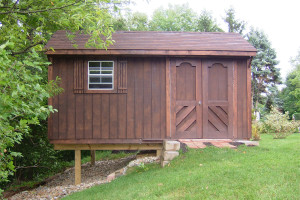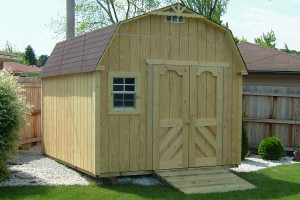One of the most common questions we are asked is how a customer should prepare their yard before having a new shed built. If you search Google for “Shed site preparation Cleveland, OH”, more than 11,000,000 results come up.
With so much information at your fingertips, its easy to find hundreds of different opinions for how to prepare your new shed’s building site, but in reality, the amount of preparation that needs to be done is dependent on which kind of foundation you choose to have.
In the forthcoming series of articles, we will focus on different types of foundations that you can choose to use, and the different needs of each foundations. Each article will cover the pros, and cons of each type of shed foundation, and why you may choose one type of shed foundation over another type. Because your needs are probably different that your neighbors, your shed foundation decisions will be based on what you intend to store in your new shed, how often you intend to use it, the condition of your yard, and the topography of your yard.
There are four basic types of shed foundations:
Cement Block Foundation
Over 90% of our customers are very well served by using the cement patio blocks for their shed’s foundation. If your shed is going to be used for general storage, such as a heavy lawn tractor, snow blower, bikes, and lawn furniture, this foundation type will be easily strong enough for the job, and will cost you very little in terms of time and money.
Posting and Post-And-Beam Foundations:
If your yard is drastically sloped, greater than 20″ over 12′, you may want to consider some inexpensive posting underneath your shed. If your yard has standing water problems for much of the year, where the ground is actually holding puddles of water, you may need to have us install a posting or post-and-beam foundation. Post-And-Beam shed foundations typically don’t take long to install, and last for decades.
Cement Floors:
If you intend to use your new shed for a daily used garage facility, where you will be bringing in large amounts of road chemicals and constantly soaking the floor, or if the floor will be constantly wet, such as a pump house or pool house, a cement floor may be a better option for you. Also, if you’re going to use your new storage shed for agricultural or commercial use where you will be dropping heavy implements on the floor, a cement floor in your shed may be the best decision. Storage Buildings Unlimited doesn’t do concrete work, but will be happy to refer you to a cement contractor in the area that has shown us good work in the past.
Gravel Pads:
Gravel pads are largely unnecessary for our sheds, and other than for aesthetic purposes, should be largely avoided. Its been our experience over 20 years of building that they are rarely level, tend to hold water under the shed much like a French drain would, and usually exhibit settling that is more difficult to fix than a block foundation. They are also quite expensive, with costs approaching the costs of the shed itself at times. If you desire the look of a gravel pad underneath of your shed, we recommend that you use the cement patio block foundation, but after the shed is completed, install a gravel parameter around the shed, to mimic the look of a total gravel pad.
Please bookmark this blog for updates to our shed foundation series of articles. Follow us on Twitter at @SBUSHEDS, and on Pinterest at @SBUSHEDS.



Recent Comments